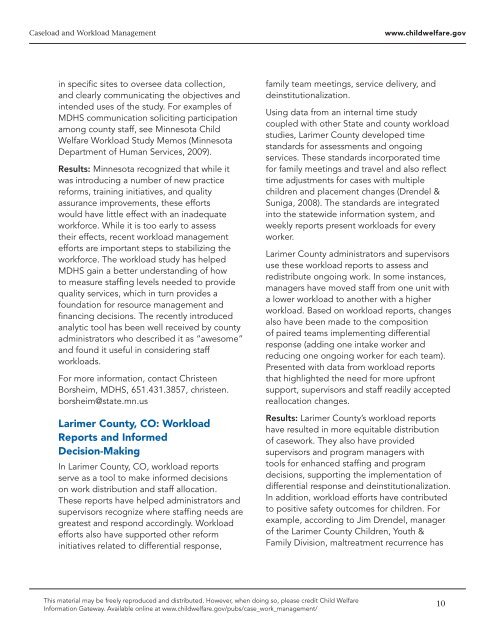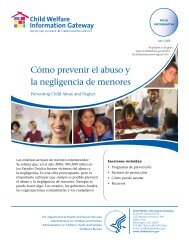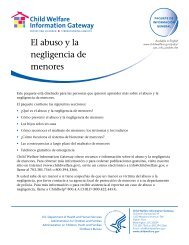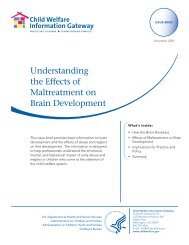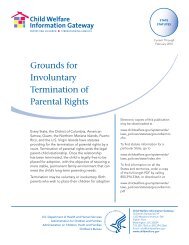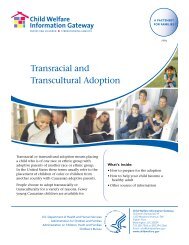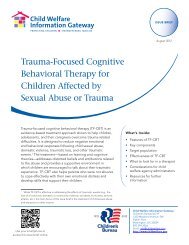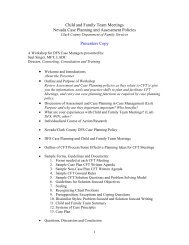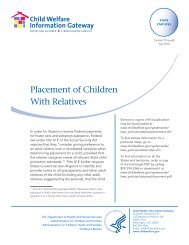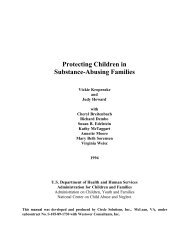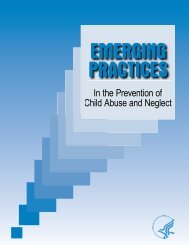Caseload and Workload Management - Child Welfare Information ...
Caseload and Workload Management - Child Welfare Information ...
Caseload and Workload Management - Child Welfare Information ...
Create successful ePaper yourself
Turn your PDF publications into a flip-book with our unique Google optimized e-Paper software.
<strong>Caseload</strong> <strong>and</strong> <strong>Workload</strong> <strong>Management</strong> www.childwelfare.gov<br />
in specific sites to oversee data collection,<br />
<strong>and</strong> clearly communicating the objectives <strong>and</strong><br />
intended uses of the study. For examples of<br />
MDHS communication soliciting participation<br />
among county staff, see Minnesota <strong>Child</strong><br />
<strong>Welfare</strong> <strong>Workload</strong> Study Memos (Minnesota<br />
Department of Human Services, 2009).<br />
Results: Minnesota recognized that while it<br />
was introducing a number of new practice<br />
reforms, training initiatives, <strong>and</strong> quality<br />
assurance improvements, these efforts<br />
would have little effect with an inadequate<br />
workforce. While it is too early to assess<br />
their effects, recent workload management<br />
efforts are important steps to stabilizing the<br />
workforce. The workload study has helped<br />
MDHS gain a better underst<strong>and</strong>ing of how<br />
to measure staffing levels needed to provide<br />
quality services, which in turn provides a<br />
foundation for resource management <strong>and</strong><br />
financing decisions. The recently introduced<br />
analytic tool has been well received by county<br />
administrators who described it as “awesome”<br />
<strong>and</strong> found it useful in considering staff<br />
workloads.<br />
For more information, contact Christeen<br />
Borsheim, MDHS, 651.431.3857, christeen.<br />
borsheim@state.mn.us<br />
Larimer County, CO: <strong>Workload</strong><br />
reports <strong>and</strong> Informed<br />
Decision-Making<br />
In Larimer County, CO, workload reports<br />
serve as a tool to make informed decisions<br />
on work distribution <strong>and</strong> staff allocation.<br />
These reports have helped administrators <strong>and</strong><br />
supervisors recognize where staffing needs are<br />
greatest <strong>and</strong> respond accordingly. <strong>Workload</strong><br />
efforts also have supported other reform<br />
initiatives related to differential response,<br />
family team meetings, service delivery, <strong>and</strong><br />
deinstitutionalization.<br />
Using data from an internal time study<br />
coupled with other State <strong>and</strong> county workload<br />
studies, Larimer County developed time<br />
st<strong>and</strong>ards for assessments <strong>and</strong> ongoing<br />
services. These st<strong>and</strong>ards incorporated time<br />
for family meetings <strong>and</strong> travel <strong>and</strong> also reflect<br />
time adjustments for cases with multiple<br />
children <strong>and</strong> placement changes (Drendel &<br />
Suniga, 2008). The st<strong>and</strong>ards are integrated<br />
into the statewide information system, <strong>and</strong><br />
weekly reports present workloads for every<br />
worker.<br />
Larimer County administrators <strong>and</strong> supervisors<br />
use these workload reports to assess <strong>and</strong><br />
redistribute ongoing work. In some instances,<br />
managers have moved staff from one unit with<br />
a lower workload to another with a higher<br />
workload. Based on workload reports, changes<br />
also have been made to the composition<br />
of paired teams implementing differential<br />
response (adding one intake worker <strong>and</strong><br />
reducing one ongoing worker for each team).<br />
Presented with data from workload reports<br />
that highlighted the need for more upfront<br />
support, supervisors <strong>and</strong> staff readily accepted<br />
reallocation changes.<br />
Results: Larimer County’s workload reports<br />
have resulted in more equitable distribution<br />
of casework. They also have provided<br />
supervisors <strong>and</strong> program managers with<br />
tools for enhanced staffing <strong>and</strong> program<br />
decisions, supporting the implementation of<br />
differential response <strong>and</strong> deinstitutionalization.<br />
In addition, workload efforts have contributed<br />
to positive safety outcomes for children. For<br />
example, according to Jim Drendel, manager<br />
of the Larimer County <strong>Child</strong>ren, Youth &<br />
Family Division, maltreatment recurrence has<br />
This material may be freely reproduced <strong>and</strong> distributed. However, when doing so, please credit <strong>Child</strong> <strong>Welfare</strong><br />
<strong>Information</strong> Gateway. Available online at www.childwelfare.gov/pubs/case_work_management/<br />
10


